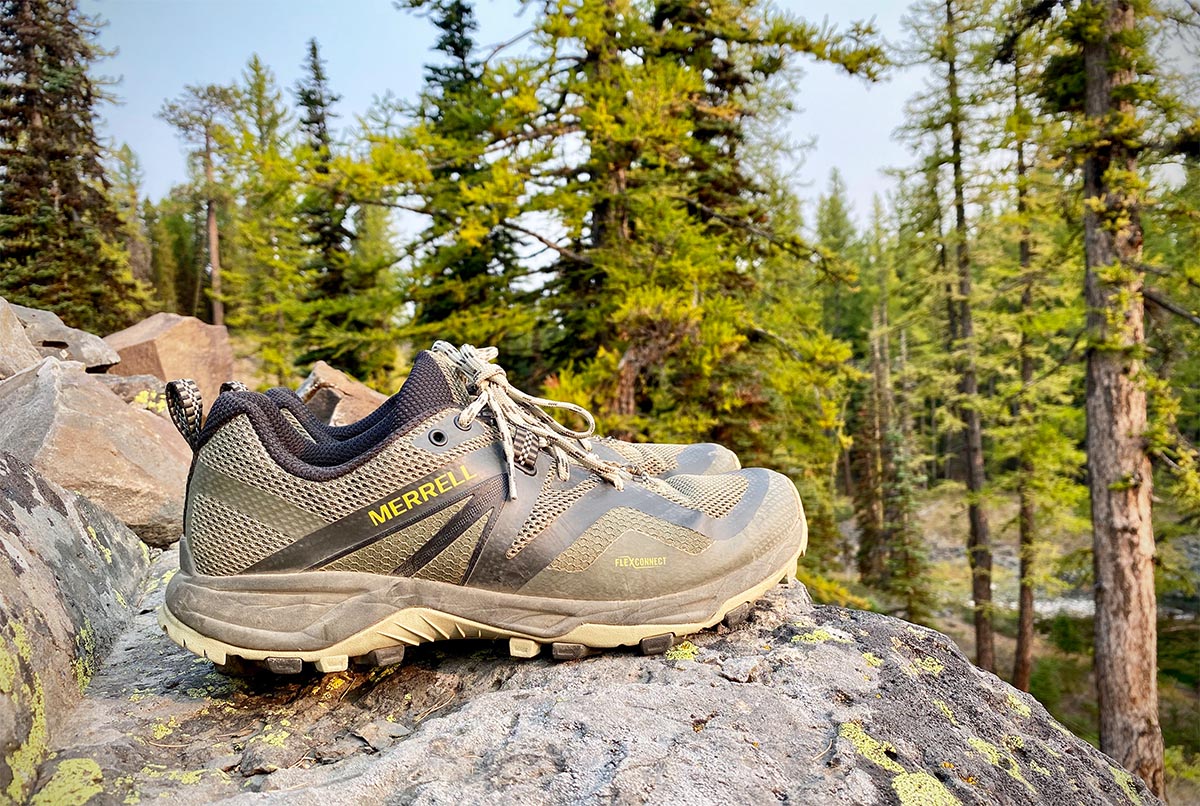
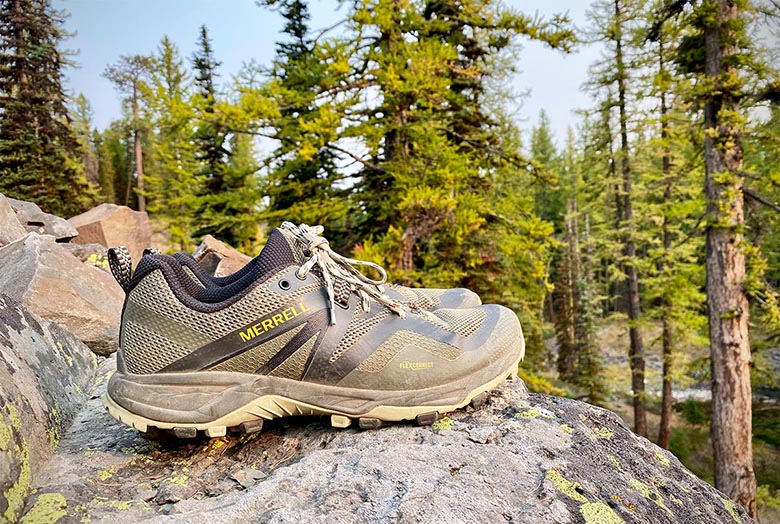
Switchback Travel


Switchback Travel
Price: $110
Weight: 1 lb. 7.7 oz. (men’s size 9)
Waterproof: No (waterproof available)
What we like: Light and nimble for covering ground quickly.
What we don’t: Durability concerns with the outsole.
See the Men's Merrell MQM Flex 2 See the Women's Merrell MQM Flex 2
The growing popularity of wearing trail running shoes for hiking has pushed the market towards lighter and nimbler designs. Merrell’s offering in this category is their hybrid MQM Flex, which aims to combine a hiking shoe, trail runner, and moderate approach shoe into one. We put the second-generation model to the test in the Washington’s Cascade Mountains and have come away with mixed feelings. On one hand, the shoe is light and makes it easy to put on miles, but we experienced some concerning durability issues with the revamped outsole. Below we break down our experiences with the MQM Flex 2. To see how it stacks up, see our article on the best hiking shoes.
Putting on the Merrell MQM Flex 2, it’s immediately clear this shoe is a completely different animal than their Moab 2 hiker. The padding around the heel is pretty thin, and the cushioning underfoot is a far cry from the thick foam you get with their most popular design. On the plus side, the MQM feels a lot like a trail runner: it’s light, very flexible under the forefoot, and its low stack height keeps you close to the trail. And with a rock plate in the midsole, you get a dose of protection for traveling over rough trails when hauling an overnight load or running.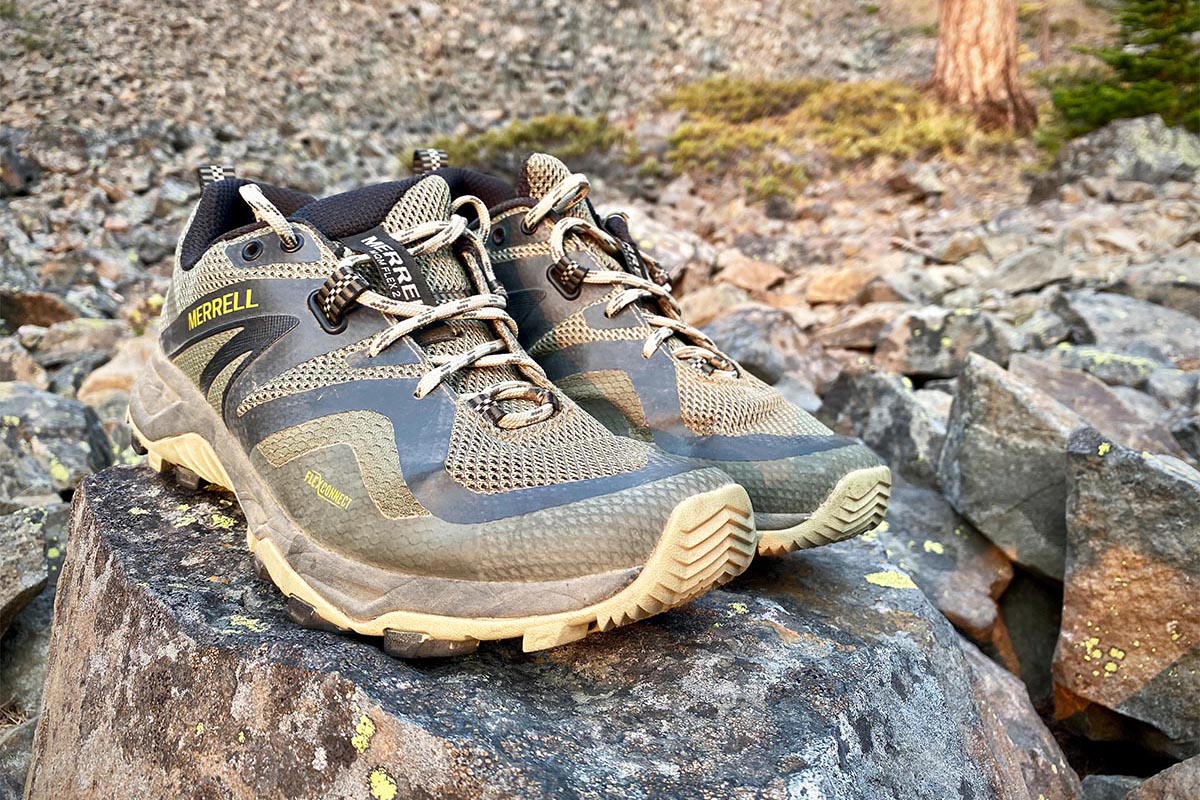
In terms of best uses, the shoe lines up nicely for ambitious day hikes, short trail runs, and ultralight backpacking. But like the original MQM Flex, we found that comfort degraded if we were carrying a heavy pack or if the terrain was particularly technical and rocky. It doesn’t absorb impacts as well as a more cushioned design, which can lead to foot soreness as the miles add up. In the end, the MQM Flex 2 can’t match the outright comfort of alternatives like Salomon’s X Raise or X Ultra 3, Danner’s Trail 2650, or Merrell’s own Moab 2, but it’s sufficient for moderate trails and when hauling light loads.
On our scale, a men’s size 9 of the non-waterproof model weighed in at 1 pound 7.7 ounces, which is exactly the same as the first-generation (the listed weight is 1 lb. 9 oz.). And the waterproof GTX version came in at 1 pound 8.5 ounces (again for a men’s size 9). Stacked up to the competition, the shoe undercuts Salomon's popular X Ultra 3 by about an ounce per shoe, but the Salomon gets you a jump in comfort, support, and traction. On the fast-and-light end of the spectrum, you can shave a bit of weight with Salomon’s X Raise (1 lb. 5.5 oz.) or a pair of hiking-ready trail runners like the Altra Lone Peak 5 (1 lb. 6.2 oz.) and Hoka One One Speedgoat 4 (1 lb. 5.6 oz.). Taken together, the MQM isn’t an ultralight standout, but it’s undoubtedly light and easy to manage on the trail.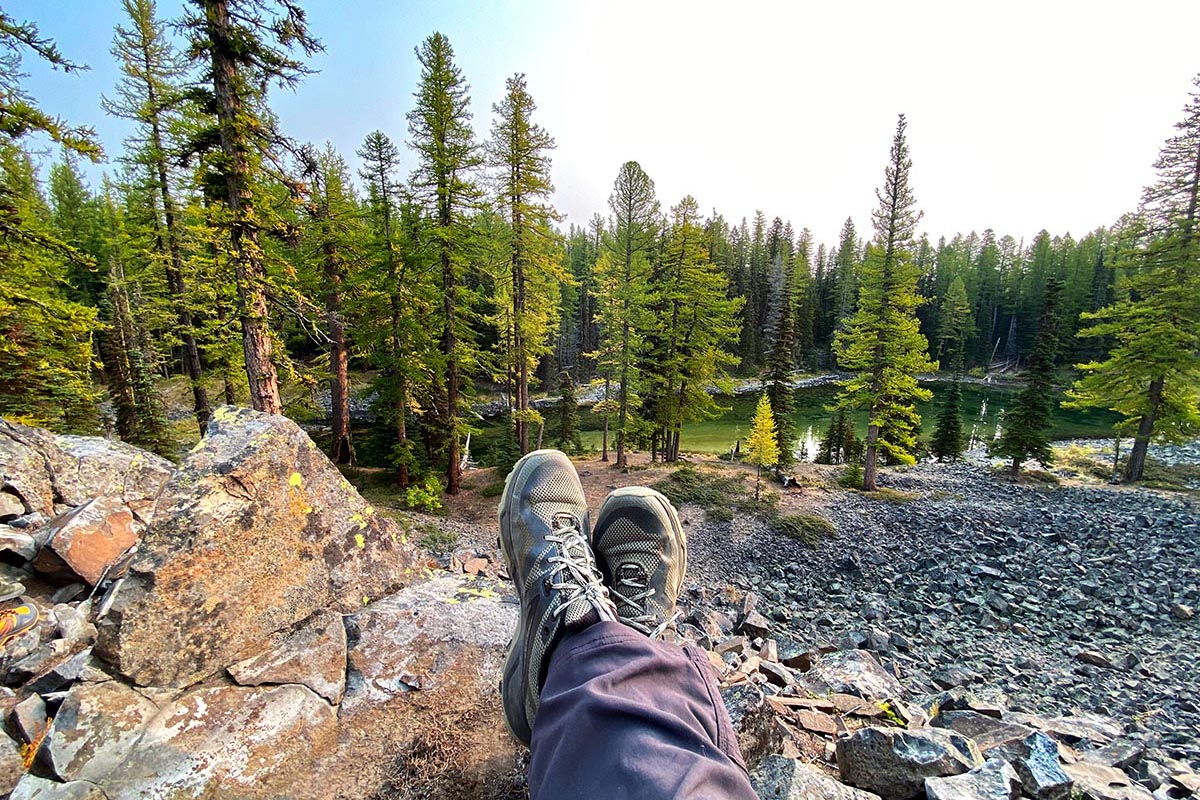
The original MQM Flex was a letdown in traction—its tread was too shallow and we found it surprisingly slippery on rock—but Merrell gave the second-generation shoe a big upgrade. Most notably, the outsole now has substantial lugs that bite into dirt and mud very effectively, an aggressive shape the holds nicely on steep slopes (both while climbing and descending), and the rubber itself is tacky and is easy to trust on rock. All in all, it’s an improvement almost across the board, although the thicker tread doesn’t feel as natural while running (it tilts more to the hiking end of the spectrum, which should be fine for most folks).
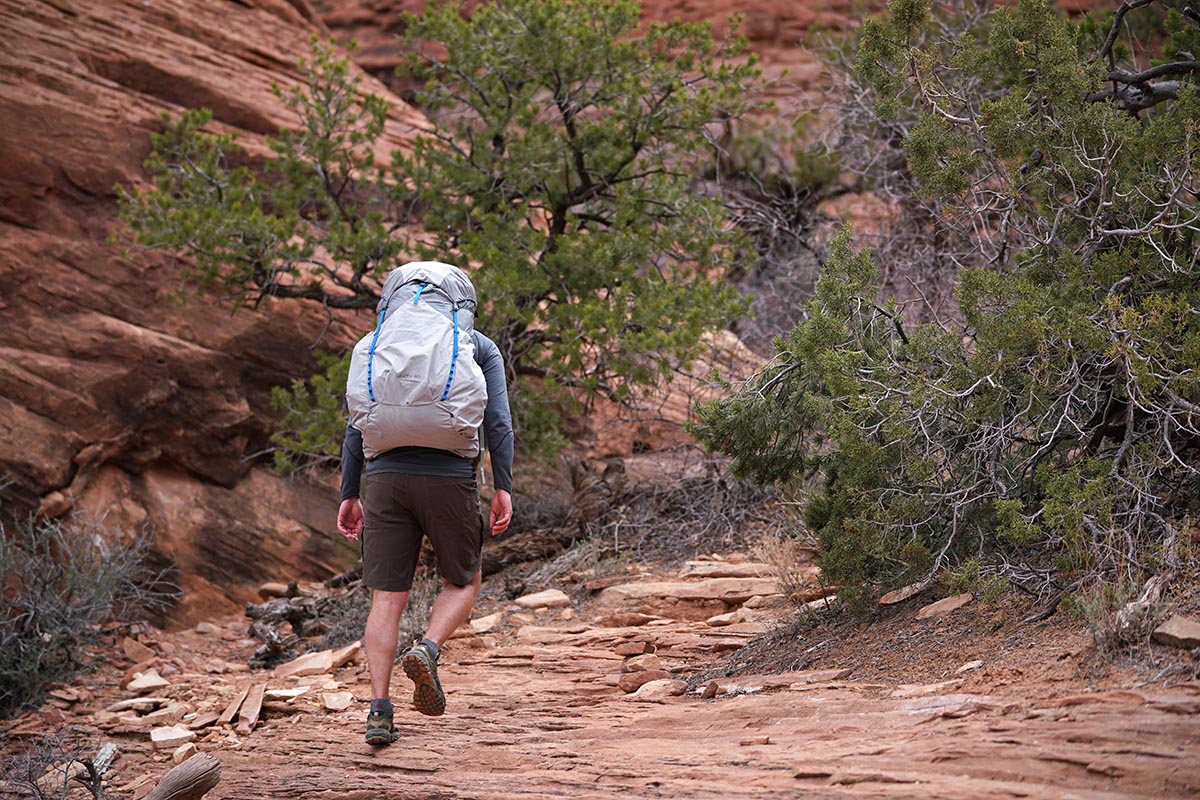
Our only concern—and it’s a pretty big one—is the durability of the rubber. The individual, pod-like tread is pretty flexible, and on the rough granite trails in the North Cascades, we’ve had issues with the lugs under the toes tearing almost completely off. In pinpointing the problem, it seems there’s too much “give” in the rubber, and the raised sections make it vulnerable to excessive wear. Those who spend the majority of their time on easier, well-maintained trails shouldn't have an issue, but for serious hiking and even lightweight backpacking, this is definitely a consideration to weigh.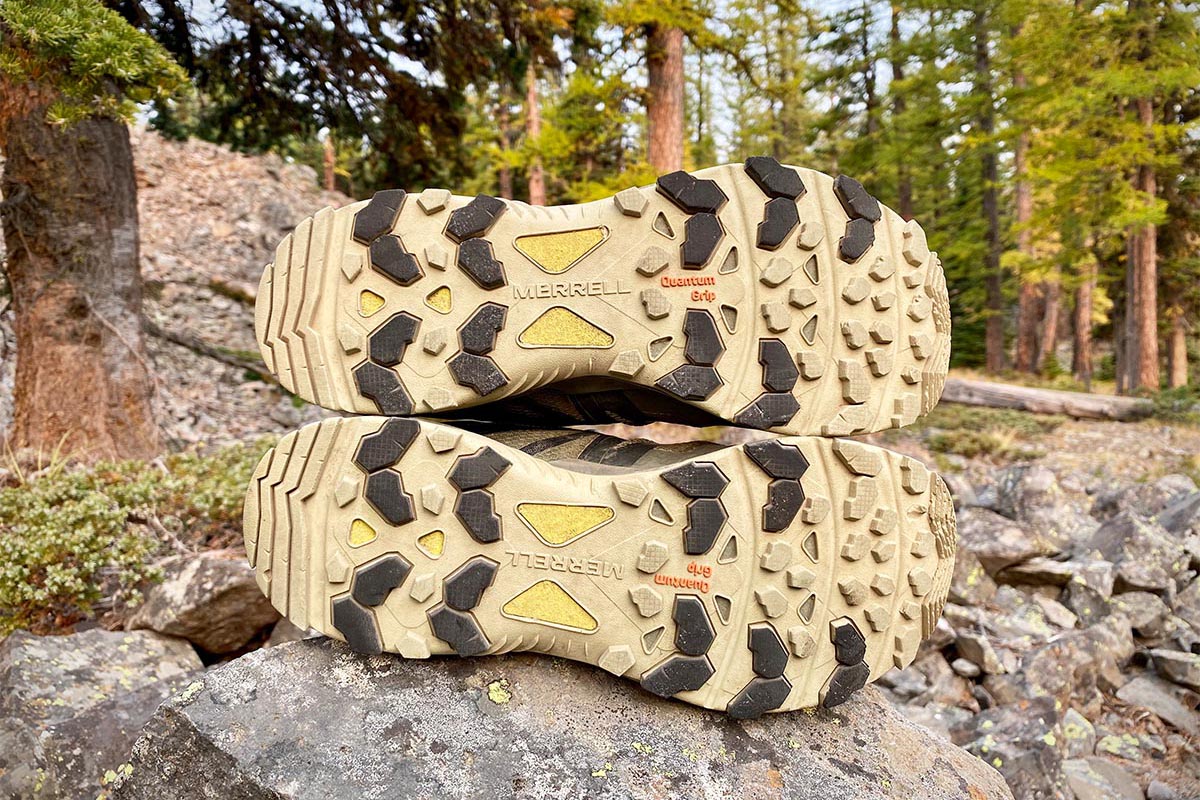
In terms of stability and support, the MQM Flex 2 more closely resembles a burly trail runner than a typical hiking shoe. The heel cup is fairly solid, which helps keep ankle rolls to a minimum, but it doesn’t have the wide footprint or planted feel of a shoe like the Moab 2. That being said, I had no complaints while hauling a load of just under 30 pounds or lighter weights while day hiking. If you’ll be carrying much more weight, however, or just prefer a sturdier shoe, there are plenty of more capable options. For low-tops, the La Sportiva Spire GTX is almost boot-like in its stability, and Salomon’s X Ultra 3 also offers better support.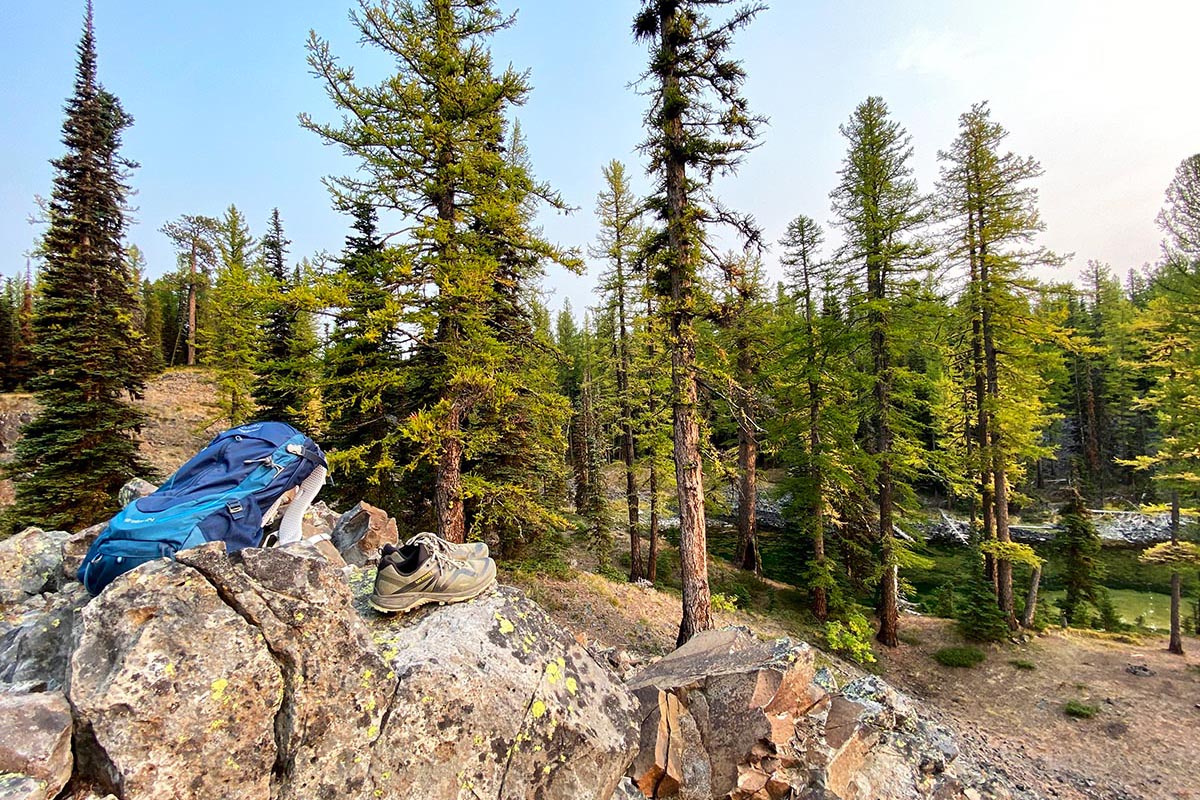
For most of the test, I wore the non-waterproof version of the MQM Flex 2, which is unsurprisingly a poor performer in the wet. When crossing streams, the mesh upper quickly takes in water, but the upside is that the shoe dries out quickly in sunny and warm weather. Merrell does offer a Gore-Tex version of the shoe (more on this below), which would likely be the preferred option if you plan to hike in the cooler shoulder seasons or need the added protection. Like most Gore-Tex shoes we’ve worn, it’s reliable for keeping moisture out, although the low ankle height means you need to be conscious of the depth of stream or mud you’ll be walking in to avoid getting the interior soaked (the GTX model dries much slower).
The advantage of a non-waterproof shoe with liberal use of mesh is that it’s very comfortable in the heat. I wore the MQM Flex 2 throughout the spring and summer in central Washington State without issues, and I’ve stayed mostly comfortable in temperatures reaching the high 80s Fahrenheit. Interestingly, I’ve found the MQM does run a little warmer than the Moab 2 Ventilator—perhaps because it doesn’t use as much open-weave mesh—but it’s still a much better breather than any Gore-Tex model (including the MQM Flex 2 GTX) out there for summer adventuring.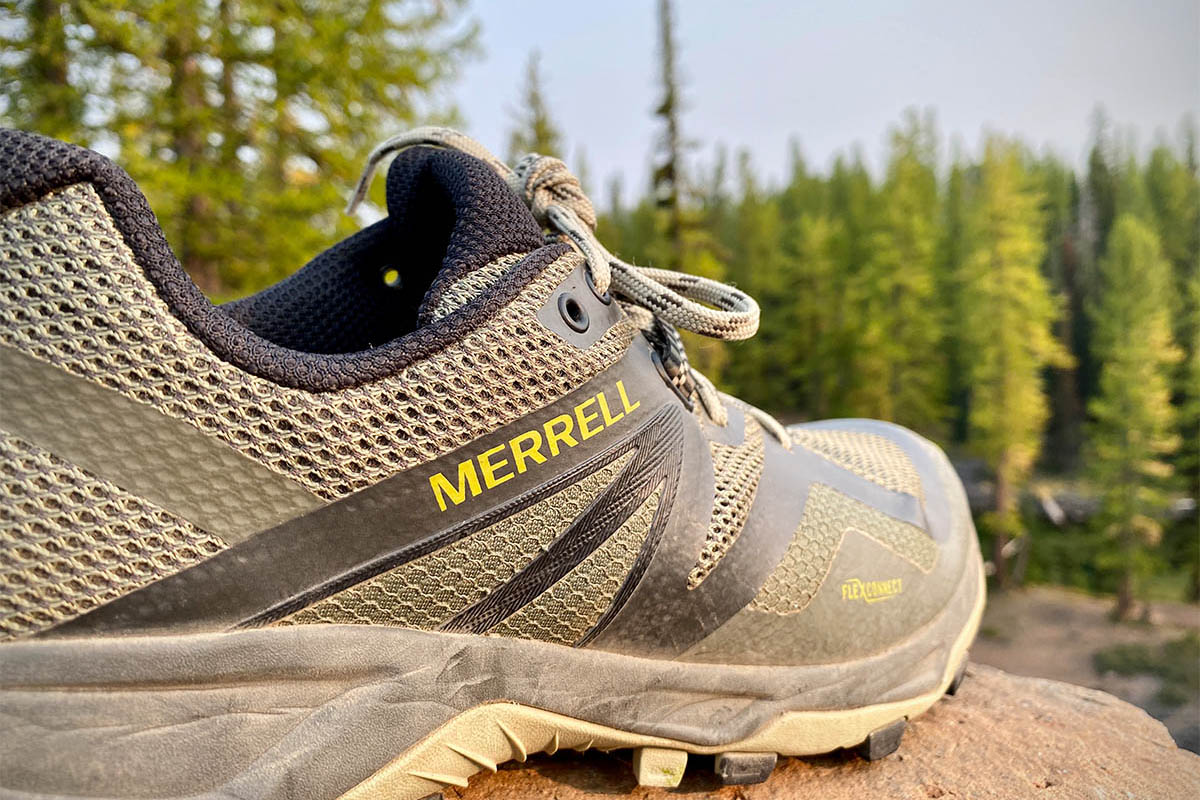
As we touched on in the traction section above, the durability of the new outsole is the biggest knock against the MQM Flex 2. While hiking over rocky terrain (and rough granite in particular), the tread wore quickly, and in some instances, the pod-like lugs tore off completely. If your trails aren’t especially rough—the North Cascades do have a reputation for being hard on lightweight footwear—this may not be an issue. But it’s a notable downside of the updated lug design, and one that we don’t run into that often among quality hiking shoes.
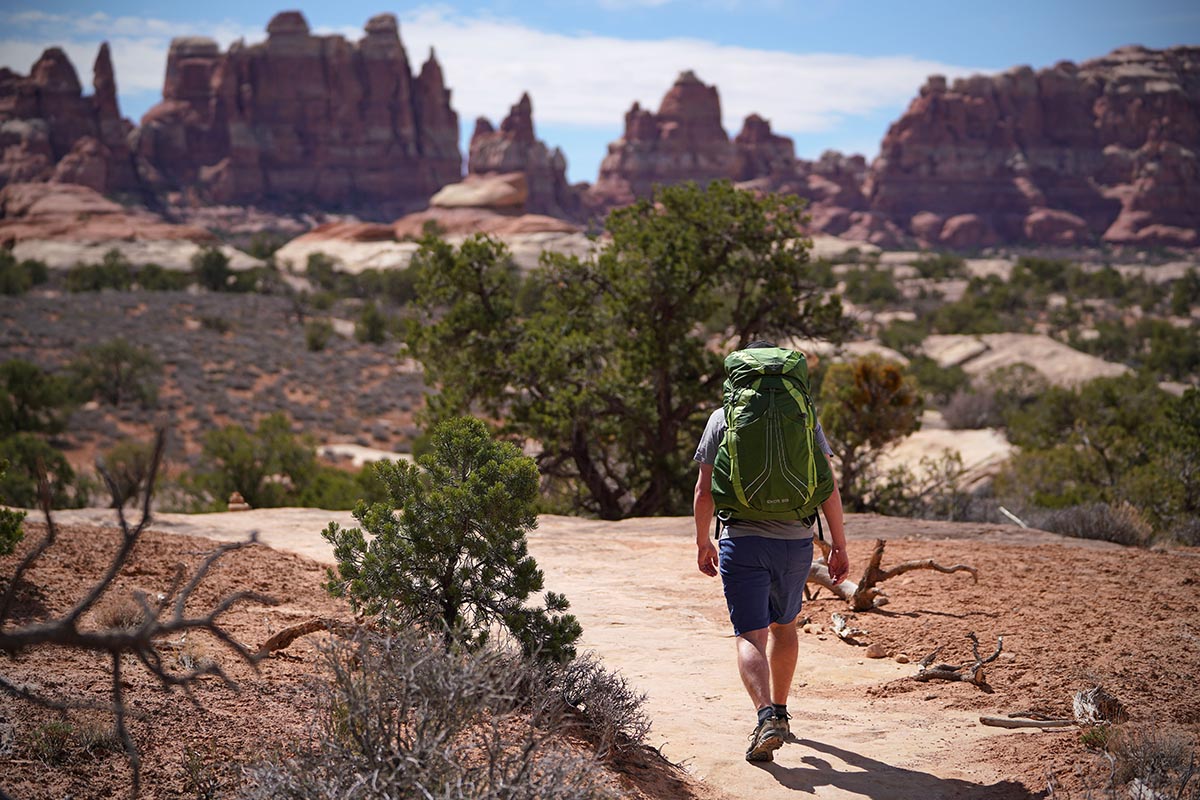
The rest of second-generation MQM Flex is reflective of the original: Merrell did a great job mixing open mesh along the top of the shoe for ventilation with tightly woven mesh and TPU reinforcements in the lower areas most prone to tearing. TPU film and a small rubber toe cap also combine to provide decent protection around the front of the foot. In about four months of use, the uppers are holding up very well, and the same goes for the lacing system and interior of the shoe.
Merrell is fairly consistent with its sizing, and we like the overall fit of the MQM Flex 2. Like their popular Moab 2 model (see our in-depth review here), the shoe has a generous toe box and is snug enough in the heel to keep things locked in place. I ordered my usual men’s 9 and felt it was very true to size. The length and width were great for hiking and running in the heat, but it didn’t feel sloppy or unstable on uneven terrain. Further, the lacing system does a nice job tightening evenly around the midfoot, and I haven’t had any issues with it loosening throughout the day.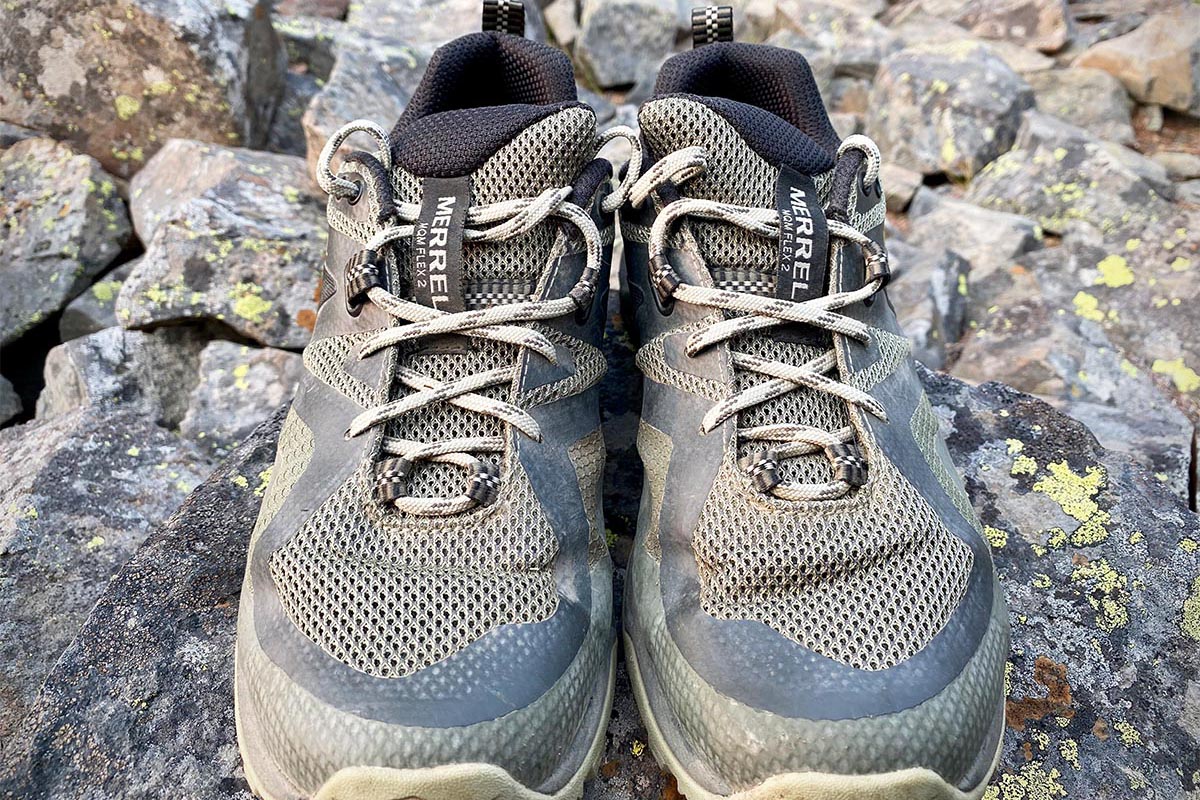
This review focuses on the men’s non-waterproof, low-top version of the MQM Flex 2, but we’ve also spent time testing the Gore-Tex model ($140). This design features Gore’s latest Invisible Fit, which bonds the waterproof bootie to the shoe, providing seamless integration. We appreciate the improved comfort—the MQM Flex’s liner is softer than a standard Gore-Tex design—and it’s proven to be just as waterproof as ever. As expected, the downside of the waterproof model is a drop in breathability, and it also takes longer to dry should you get it wet. Rounding out the MQM collection, Merrell also makes a mid-height GTX model, and women’s versions are available in all designs. The women’s variations are nearly identical in overall construction but weigh slightly less than their men’s counterparts and are sold in different colorways.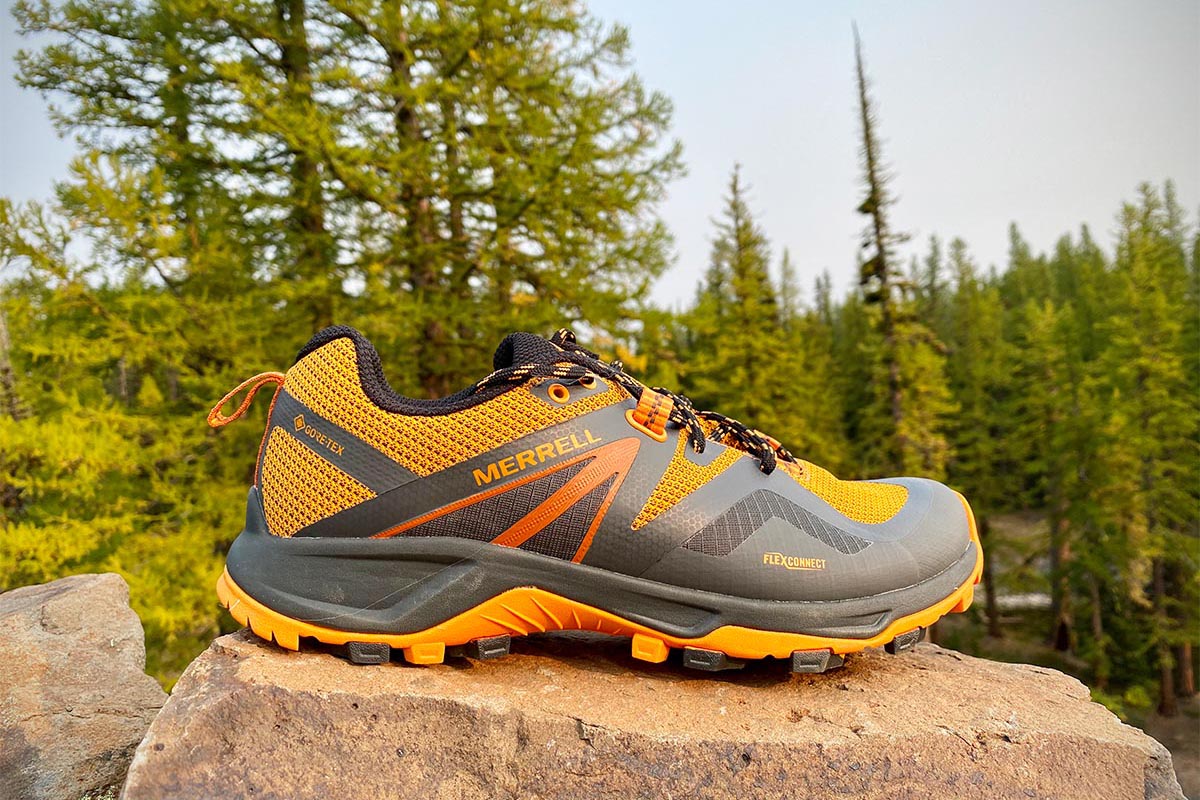
| Shoe | Price | Type | Weight | Waterproof | Upper |
|---|---|---|---|---|---|
| Merrell MQM Flex 2 | $110 | Hiking shoe/trail runner | 1 lb. 9 oz. | No | Mesh |
| Salomon X Ultra 3 Aero | $120 | Hiking shoe | 1 lb. 9.8 oz. | No | Synthetic |
| Salomon X Raise | $110 | Hiking shoe/trail runner | 1 lb. 5.5 oz. | No | Synthetic |
| Danner Trail 2650 | $150 | Hiking shoe | 1 lb. 8 oz. | No | Leather / textile |
| Altra Lone Peak 5 | $130 | Trail runner | 1 lb. 6.2 oz. | No | Mesh |
| Merrell Moab 2 Ventilator | $100 | Hiking shoe | 1 lb. 15 oz. | No | Leather / mesh |
The lightweight hiker market is pretty crowded, but the MQM Flex 2’s combination of weight and good looks—along with the well-known Merrell name—makes it a popular choice. For 2021, our favorite overall hiking shoe is Salomon’s X Ultra 3. The Merrell gets the slight edge in weight, and it’s also easier to run in with its more flexible construction and lower ankle height. But in all other respects, the X Ultra 3 is simply better. It has a longer-lasting yet similar-performing outsole, and it's more comfortable and cushioned underfoot for long hikes and backpacking trips. For only $10 more, we highly recommend spending up for the boosts in performance and longevity.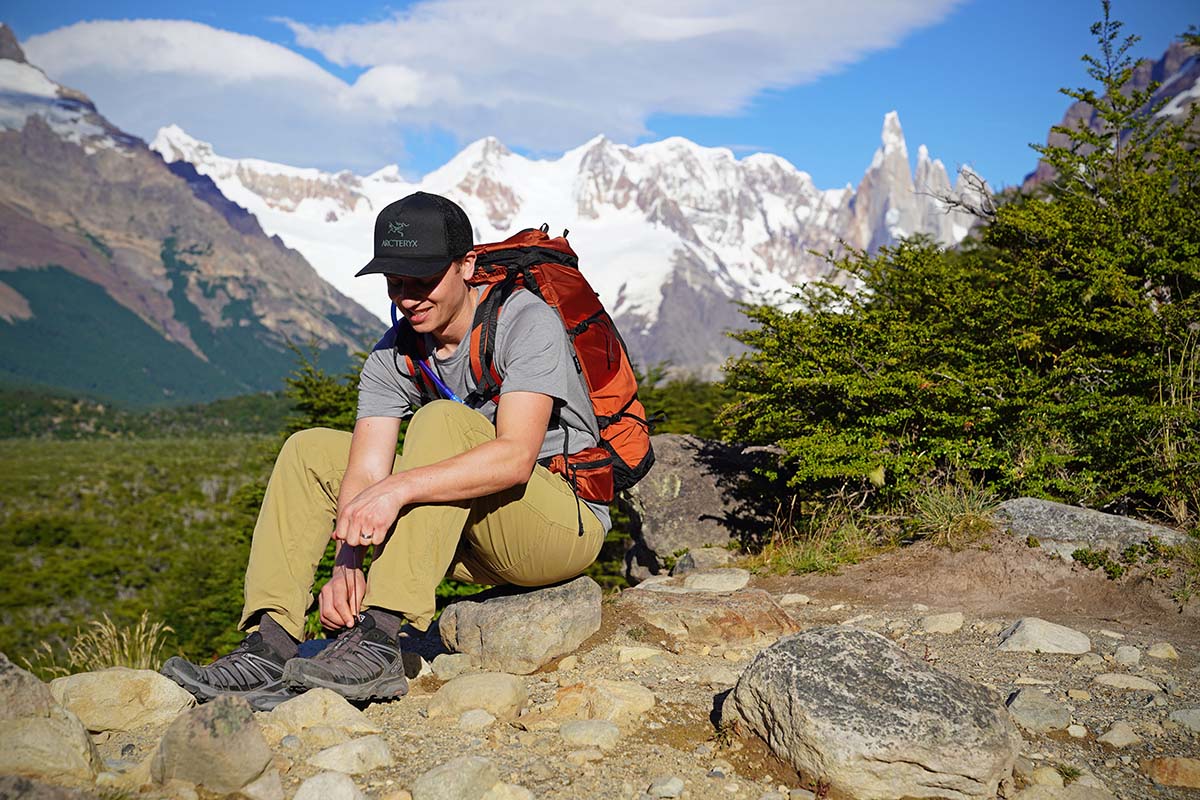
Another close competitor to consider is Salomon’s X Raise, which is another fast-and-light day hiker that crosses over nicely for lightweight backpacking. As we mentioned above, the Salomon undercuts the Merrell by around 4 ounces per pair, which gave the shoe a noticeably light and nimble feel on the trail. The X Raise is also more padded underfoot, which translates to more comfort when covering long distances (at the sacrifice of some agility). Some will find the Salomon’s Quicklace system to be a bit polarizing and harder to customize fit than the MQM Flex’s traditional laces, and the Merrell is grippier in the wet (the X Raise was surprisingly slippery and difficult to trust in wet conditions). But given the durability issues we experienced with the Merrell’s outsole, we think the Salomon is the better-built hiker at this price point.
Like the X Raise, Danner’s Trail 2650 nicely balances weight (1 lb. 8 oz.) and cushioning. At $150, the Trail 2650 costs $40 more than the Merrell, but you get notable upgrades including a superior and grippier Vibram outsole, high-quality leather upper, and good-looking build. In fact, we consider the Danner one of the best options on the market for crossing over into daily wear. We did find the Danner to be fairly narrow (there’s a wide version available), and the large patch of rubber at the heel feels a bit overkill and polarizing. But given the considerable increases in daily appeal and traction, we consider the Danner the more well-rounded lightweight hiker.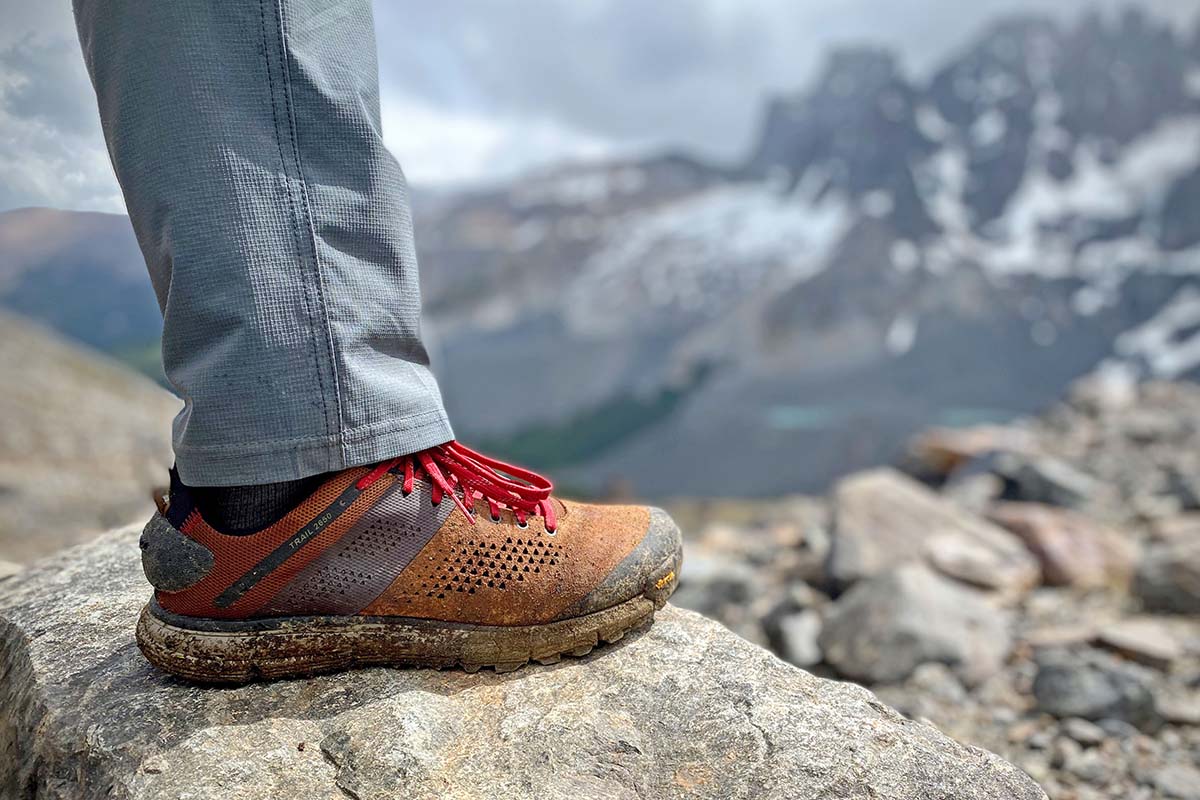
The MQM Flex’s lightweight hybrid design also puts it in the crosshairs of one of the top trail running shoes: Altra’s Lone Peak 5. Right off the bat, we'll note that this shoe has developed a strong following among thru-hikers with its supportive cushioning, wide toe box, and solid traction. Altra even includes nice touches for long-distance hikers like attachment points for a pair of gaiters. Compared with the MQM Flex, the Merrell has the upper hand in durability, but we give the advantage to the Lone Peak because it’s more comfortable, weighs around 3 ounces less, and has a more proven outsole.
A final lightweight option to consider comes from within Merrell’s own lineup: the Moab 2 Ventilator. The Moab is the more traditional hiking design with a leather and mesh upper, Vibram tread, and heavier build (1 lb. 15 oz.). As we mentioned above with the Salomon X Ultra 3, the MQM Flex 2 wins out for running with its trimmed-down construction, but the Moab is our preferred option for longer hikes and light backpacking due to its superior cushioning and comfort. Neither shoe is ideal for heavy loads or technical terrain (we’d upgrade to a burlier low-top design or mid-height boot in these cases), but the Moab is the better all-rounder.
If you’re thinking about buying gear that we’ve reviewed on Switchback Travel, you can help support us in the process. Just click on any of the seller links above, and if you make a purchase, we receive a small percentage of the transaction. The cost of the product is the same to you but this helps us continue to test and write about outdoor gear. Thanks and we appreciate your support!
Depending on the seller, most products ship free in the United States on orders of $50 or more. International shipping availability and rates vary by seller. The pricing information on this page is updated hourly but we are not responsible for inaccuracies.